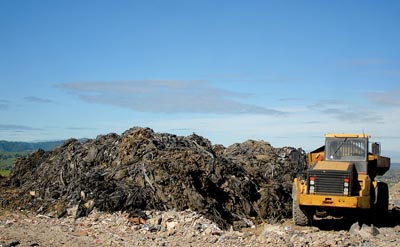
In at least one way, declining fuel costs have hurt local
taxpayers, and there’s a thousand-ton pile of plastic to show for
it at the John Smith Landfill.
In at least one way, declining fuel costs have hurt local taxpayers, and there’s a thousand-ton pile of plastic to show for it at the John Smith Landfill.
That heap of agricultural plastic – much of it used in farm fields – has grown to such massive proportions at the local landfill since June 2009 because Integrated Waste Management had lowered the drop-off fee from $57 to $26. It was meant as an incentive for local farmers so the landfill could stockpile the plastic, and it appeared to make sense at the time because two companies in the Central Valley had expressed serious interest in a deal for the material.
Such manufacturing companies generally use the recycled plastic to either process it into pellets for remolding, or they use its “energy value” toward making fuel, said Mandy Rose, director of Integrated Waste Management.
“Everybody wanted this plastic to make some kind of transportation fuel,” said Rose.
That was when the cost of fuel was higher, though, and since then, the market for such plastic has become a lot less lucrative. Those two companies, therefore, have informed landfill officials that they no longer have interest in a deal for the material – to transport it at no cost to the county.
Now the John Smith Landfill has 1,000 tons of the agricultural plastic piled at the site, and officials are under the gun – due to environmental regulations on how long they can keep it stored there – to dispose of it. Rose referred to the pile as her latest “Mt. Vesuvius.”
In getting back to the two companies recently, they had not only backed off on the original offer, but they also were requesting $40 a ton to pick it up.
Said Rose, who reported the unfortunate news to supervisors last week, “That decision sort of made itself.”
Complicating the prospects for San Benito County is that much of the plastic has relatively high concentrations of herbicides and pesticides, she noted. That means its potential, alternative uses are limited mostly to the possibility of processing the plastic for fuel. There are none of these manufacturing plants closer than Tulare, either, which dims prospects of making such a deal due to the associated transportation costs.
“Suppliers, just like anything else, got to be more particular about what they accepted,” Rose said.
Officials have decided the only option at this point for the pile of plastic is to use it at the landfill as “fluff layer” – which is a federally-required foot of cushion to the liner that is placed before dropping in the regular garbage. Landfill workers are in the process of preparing it for that use.
For the full story, see the Free Lance on Tuesday.









